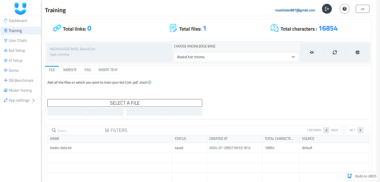Microsoft To Do MCP
This MCP (Model Context Protocol) service allows you to interact with Microsoft To Do tasks using an AI assistant.
Setup Instructions
1. Prerequisites
- Node.js 16 or higher
- npm
- A Microsoft account
- Azure App Registration (see setup below)
2. Installation
There are two parts to installing this tool:
- Installing the package
- Setting up authentication (requires cloning the repository)
Step 1: Install the Package
npm install -g @jhirono/todomcp
Step 2: Set Up Authentication
Even if you install the package globally, you’ll need to clone the repository to complete the authentication process:
git clone https://github.com/jhirono/todoMCP.git
cd todoMCP
npm install
3. Azure App Registration
- Go to the Azure Portal
- Navigate to “App registrations” and create a new registration
- Name your application (e.g., “To Do MCP”)
- For “Supported account types”, select one of the following based on your needs:
- Accounts in this organizational directory only (Single tenant) - For use within a single organization
- Accounts in any organizational directory (Any Azure AD directory - Multitenant) - For use across multiple organizations
- Accounts in any organizational directory and personal Microsoft accounts - For both work accounts and personal accounts
- Set the Redirect URI to
http://localhost:3000/callback - After creating the app, go to “Certificates & secrets” and create a new client secret
- Go to “API permissions” and add the following permissions:
- Microsoft Graph > Delegated permissions:
- Tasks.Read
- Tasks.ReadWrite
- User.Read
- Microsoft Graph > Delegated permissions:
- Click “Grant admin consent” for these permissions
4. Configuration
Create a .env file in the root directory with the following information:
CLIENT_ID=your_client_id
CLIENT_SECRET=your_client_secret
TENANT_ID=your_tenant_setting
REDIRECT_URI=http://localhost:3000/callback
TENANT_ID Options:
organizations- For multi-tenant organizational accounts (default if not specified)consumers- For personal Microsoft accounts onlycommon- For both organizational and personal accountsyour-specific-tenant-id- For single-tenant configurations
Examples:
# For multi-tenant organizational accounts (default)
TENANT_ID=organizations
# For personal Microsoft accounts
TENANT_ID=consumers
# For both organizational and personal accounts
TENANT_ID=common
# For a specific organization tenant
TENANT_ID=00000000-0000-0000-0000-000000000000
Usage
Complete Workflow
Authenticate to get tokens (must be done from the cloned repository)
npm run authThis will open a browser window for you to authenticate with Microsoft and create a
tokens.jsonfile.Create MCP config file (must be done from the cloned repository)
npm run create-configThis creates an
mcp.jsonfile with your authentication tokens.Set up the global MCP configuration
# Copy the mcp.json file to your global Cursor configuration directory cp mcp.json ~/.cursor/mcp-servers.jsonThis makes the Microsoft To Do MCP available across all your Cursor projects.
Start using with your AI assistant
- In Cursor, you can now use Microsoft To Do commands directly in any project
- Try commands like
auth statusorlist up todosto get started
The Claude Desktop configuration file is located at:
- macOS:
~/Library/Application Support/Claude/claude_desktop_config.json - Windows:
%APPDATA%Claudeclaude_desktop_config.json - Linux:
~/.config/Claude/claude_desktop_config.json
Available Tools
auth-status: Check your authentication statusget-task-lists: Get all your To Do task listscreate-task-list: Create a new task listupdate-task-list: Update an existing task listdelete-task-list: Delete a task listget-tasks: Get all tasks in a listcreate-task: Create a new taskupdate-task: Update an existing taskdelete-task: Delete a taskget-checklist-items: Get checklist items for a taskcreate-checklist-item: Create a checklist itemupdate-checklist-item: Update a checklist itemdelete-checklist-item: Delete a checklist item
Limitations
- The API requires proper authentication and permissions
- Rate limits may apply according to Microsoft’s policies
Troubleshooting
Authentication Issues
“MailboxNotEnabledForRESTAPI” error: This typically means you’re using a personal Microsoft account. Microsoft To Do API access is limited for personal accounts through the Graph API.
Token acquisition failures: Make sure your
CLIENT_ID,CLIENT_SECRET, andTENANT_IDare correct in your.envfile.Permission issues: Ensure you have granted admin consent for the required permissions in your Azure App registration.
Account Type Issues
Work/School Accounts: These typically work best with the To Do API. Use
TENANT_ID=organizationsor your specific tenant ID.Personal Accounts: These have limited access to the To Do API. If you must use a personal account, try
TENANT_ID=consumersorTENANT_ID=common.
Checking Authentication Status
You can check your authentication status using the auth-status tool or by examining the expiration time in your tokens:
cat tokens.json | grep expiresAt
To convert the timestamp to a readable date:
date -r $(echo "$(cat tokens.json | grep expiresAt | cut -d ":" -f2 | cut -d "," -f1) / 1000" | bc)
Microsoft Todo Service
Project Details
- jhirono/todoMCP
- @jhirono/todomcp
- Last Updated: 4/16/2025
Categories
Recomended MCP Servers
MCP Server for Trino developed via MCP Python SDK

服务器、网络设备巡检和运维MCP工具

A universal RPC layer for AI agents. Connect to any function, any language, any framework, in minutes.

A simple MCP integration that allows Claude to read and manage a personal Notion todo list

A powerful headless browser MCP server that enables AI agents to fetch web content and perform Google searches...
Amadeus MCP(Model Context Protocol) Server
Interact seamlessly with GitLab repositories to manage merge requests and issues. Fetch details, add comments, and streamline your...
Upstash Model Context Server
Now you can date a Zoom meeting with AI's help.
 From vibe coding to vibe deployment. UBOS MCP turns ideas into infra with one message.
From vibe coding to vibe deployment. UBOS MCP turns ideas into infra with one message.






